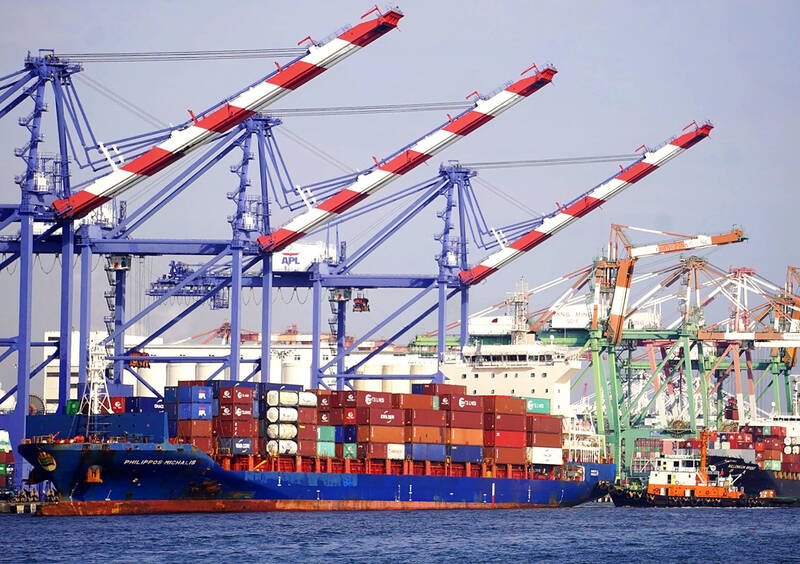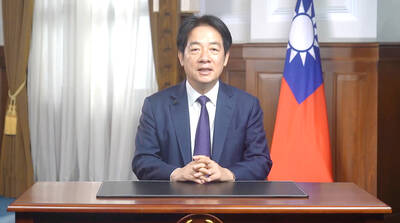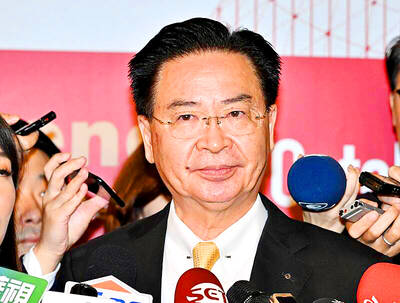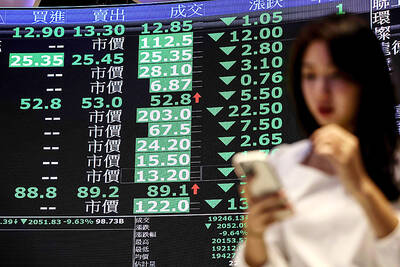Taiwan’s exports set records last year, rising more than 7 percent from a year earlier, although many exporters fell victim to weakening global demand in the second half of the year, the Ministry of Finance announced.
Exports totaled US$479.52 billion, up 7.4 percent from a year earlier, beating the previous record of US$446.37 billion recorded in 2021, data compiled by the ministry showed.
The electronic components industry served as the main driver for last year’s export growth, posting US$200.14 billion in outbound sales, up 16.4 percent from a year earlier and accounting for almost 42 percent of the total, with sales from semiconductor suppliers rising 18.4 percent to US$184.14 billion, the data showed.

Photo: CNA
However, outbound sales in the fourth quarter fell 8.6 percent from a year earlier to US$111.81 billion, with exports last month dropping 12.1 percent year-on-year to US$35.75 billion — the fourth consecutive annual monthly decline — although last month’s fall moderated from a 13.1 percent drop in November, the ministry said on Saturday.
Last month’s exports were slightly lower than an earlier estimate by the ministry, which forecast they would fall between US$35.8 billion and US$37.4 billion, down 8 to 12 percent from a year earlier.
Meanwhile, imports last year totaled US$427.6 billion, up 11.9 percent from a year earlier, with a trade surplus of US$51.92 billion.
The robust showing came even though imports last month fell 11.4 percent from a year earlier to US$30.96 billion, while the trade surplus dropped 16.7 percent year-on-year to US$4.79 billion, the ministry said.
Exporters faced headwinds in the second half of last year, caused by a decline in global demand, which paved the way for inventory adjustments in many industries, but the stronger first half helped Taiwan maintain its uptrend in exports for the full year, the ministry said.
Fast-growing inflation, which prompted aggressive rate hike cycles by major central banks around the world, discouraged consumers from spending, Department of Statistics Director-General Beatrice Tsai (蔡美娜) said.
Russia’s invasion of Ukraine continued to hurt the global economy, while a wave of COVID-19 infections in China also sent global demand into a tailspin, Tsai said.
A relatively high comparison base in December 2021 also affected last month’s exports data, she added.
All major industries last month reported a decline in outbound sales, except the semiconductor sector, which posted US$14.91 billion in exports, up 0.8 percent from a year earlier.
The broader electronic components industry, which includes semiconductor suppliers, saw exports fall 1.4 percent from a year earlier to US$16.04 billion — the second consecutive annual monthly decline, Tsai said.
The electronics industry accounted for 44.87 percent of Taiwan’s total exports last month.
Exports posted by the information and communications industry, and the video and audio industry together fell 10.7 percent year-on-year to US$5.19 billion, while exports reported by the optoelectronics sector fell 30.3 percent to US$732 million, the ministry said.
Old economy industries, in particular, felt the pinch from the global slowdown, with exports posted by the base metal, machinery, and plastics and rubber industries falling 22 percent, 9.4 percent and 33.8 percent respectively, to US$2.43 billion, US$2.24 billion and US$1.68 billion last month, the ministry said.
Exports posted by the chemical, transportation and mineral industries fell 28.4 percent, 11.6 percent and 25.4 percent respectively, to US$1.49 billion, US$1.17 billion and US$893 million, the ministry said.
While China, including Hong Kong, last month remained the largest buyer of Taiwan-made goods, exports to the country fell 16.4 percent from a year earlier to US$14.28 billion due to interruptions caused by the COVID-19 pandemic, the ministry said.
ASEAN countries were second, purchasing US$5.73 billion of Taiwanese goods, down 10.8 percent from a year earlier, while exports to the US, Europe and Japan fell 2.6 percent, 10.5 percent and 6.1 percent respectively, to US$5.67 billion, US$3.16 billion and US$2.59 billion, the ministry added.
For last year as a whole, China was the largest buyer of Taiwanese goods, with purchases totaling US$185.92 billion, down 1.6 percent from a year earlier, the ministry said.
Looking ahead, Tsai said that weakening global demand and fewer working days this month due to the 10-day Lunar New Year holiday mean Taiwan’s exports are expected to post a year-on-year decline of 20 to 24 percent to between US$30.4 billion and US$32 billion.
While many major industries are expected to continue to experience a slowdown, Tsai said that the steel industry could see a revival, as some steelmakers in the region have raised wholesale prices, expecting robust demand.

ACTION PLAN: Taiwan would expand procurement from the US and encourage more companies to invest in the US to deepen bilateral cooperation, Lai said The government would not impose reciprocal tariffs in retaliation against US levies, President William Lai (賴清德) said yesterday, as he announced five strategies to address the issue, including pledging to increase Taiwanese companies’ investments in the US. Lai has in the past few days met with administrative and national security officials, as well as representatives from various industries, to explore countermeasures after US President Donald Trump on Wednesday last week announced a 32 percent duty on Taiwanese imports. In a video released yesterday evening, Lai said that Taiwan would not retaliate against the US with higher tariffs and Taiwanese companies’ commitments to

Intelligence agents have recorded 510,000 instances of “controversial information” being spread online by the Chinese Communist Party (CCP) so far this year, the National Security Bureau (NSB) said in a report yesterday, as it warned of artificial intelligence (AI) being employed to generate destabilizing misinformation. The bureau submitted a written report to the Legislative Yuan in preparation for National Security Bureau Director-General Tsai Ming-yen’s (蔡明彥) appearance before the Foreign Affairs and National Defense Committee today. The CCP has been using cognitive warfare to divide Taiwanese society by commenting on controversial issues such as Taiwan Semiconductor Manufacturing Co’s (TSMC, 台積電) investments in the

‘SPECIAL CHANNEL’: Taipei’s most important tasks are to stabilize industries affected by Trump’s trade tariffs and keep negotiations with Washington open, a source said National Security Council Secretary-General Joseph Wu (吳釗燮) arrived in the US for talks with US President Donald Trump’s administration, a source familiar with the matter said on Friday. Wu was leading a delegation for a meeting known as the “special channel,” the Financial Times reported earlier. It marked Trump’s first use of the channel since returning to the White House on Jan. 20. Citing a source familiar with the matter, the Financial Times reported that Minister of Foreign Affairs Lin Chia-lung (林佳龍) was also a part of the delegation. The visit came days after China concluded war games around Taiwan and amid Trump’s

HELPING HAND: The steering committee of the National Stabilization Fund is expected to hold a meeting to discuss how and when to utilize the fund to help buffer the sell-off The TAIEX plunged 2,065.87 points, or 9.7 percent, to close at 19,232.35 yesterday, the highest single-day percentage loss on record, as investors braced for US President Donald Trump’s tariffs after an extended holiday weekend. Amid the pessimistic atmosphere, 945 listed companies led by large-cap stocks — including Taiwan Semiconductor Manufacturing Co (TSMC, 台積電), Hon Hai Precision Industry Co (鴻海精密) and Largan Precision Co (大立光) — fell by the daily maximum of 10 percent at the close, Taiwan Stock Exchange data showed. The number of listed companies ending limit-down set a new record, the exchange said. The TAIEX plunged by daily maxiumu in just